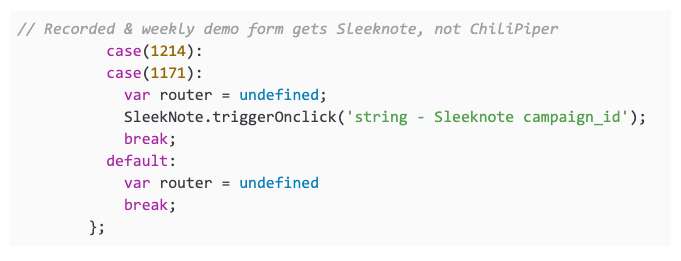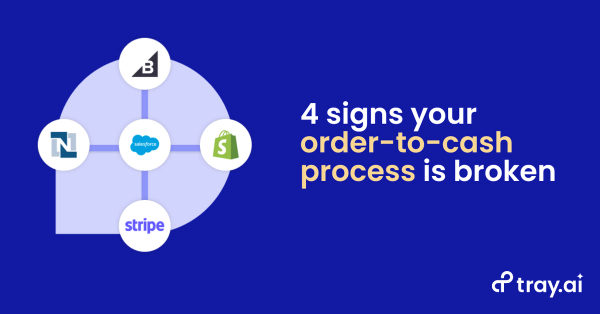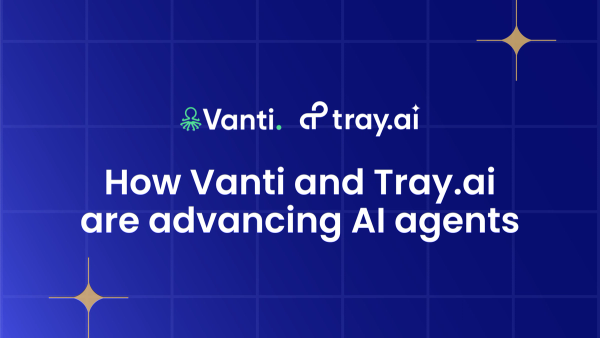This post is the second in a two-part series about using automation to identify prospects and instabook sales meetings. If you haven’t already, I suggest you take a look at my first post to see how we identify anonymous Intercom leads from web form submissions, then come back here once you’ve caught up.
In this post, I’ll show you how growth operations professionals can surface sales meetings or other offers immediately after a prospect that matches your ideal customer profile (ICP) submits a form on your website. This automated process (we call it “instabook”, since it surfaces direct booking offers immediately after a form submission) is a great way to capitalize on leads that are ‘on the hook’ after submitting a request while also reducing the friction of additional confirmation and follow-ups.
Sales friction, or the barriers and obstacles that slow down or otherwise interfere with a customer saying “yes” to a deal, results in poor customer experience and lost revenue for your company. Research estimates the cost of sales friction to be over $40 billion. It comes down to human nature: If you want to encourage a behavior, you should make it as easy and seamless as possible to complete said behavior.
With instabook in place, we see a higher number of sales meetings booked from interested prospects that could have dropped out of the sales process otherwise. Paired with our anonymous lead identification process, we use this automation to deliver a reliable, high-quality stream of prospects to our sales organization.
Walkthrough: Surfacing instant bookings after web form submissions
As a quick recap, my last post showed you how to pass form data from our marketing automation platform (MAP) through custom logic to identify anonymous leads and add that information to our web chat tool. Now, I’ll show you how to use form data to surface our instabook offers.
To do this, we’ll use some of the same tools from our last post:
- Marketo - The MAP we use to host forms on our site.
- Intercom - Our web chat solution, which fields prospects’ questions and stores their information.
- Google Tag Manager - A popular website tool that lets you add tracking elements into your website without having to modify code.
- Tray platform - A modern iPaaS that lets you integrate tools like Marketo and Intercom and orchestrate sophisticated processes with automation like the one we’ll build today.
In addition to a few new ones:
- Clearbit - Clearbit is a lead enrichment solution, which helps us find additional attributes to determine if a lead meets our ICP.
- NeverBounce - We use this to test if the prospect’s email is valid before we let them instabook.
- Chili Piper - The platform that lets us book sales meetings immediately after a prospect fills out a form.
- Sleeknote - The platform that lets us surface a pop-up message in the user’s web browser that encourages them to book 1:1 demos.
- Segment - Segment is a customer data platform that we use to track moments throughout the customer journey.
Now that we’ve identified the tools we need, let’s look at a high-level picture of how this process will come together.
First, we’ll tackle how we identify prospects that fit our ICP. This stage contains a few steps:
- When a prospect submits a new Marketo form, a callback function, delivered via Google Tag Manager (GTM), passes data from that form to a workflow in the Tray Platform.
- In the Tray Platform, we check each email in NeverBounce to confirm that it is valid before we pass it through Clearbit for enrichment.
- Depending on the results from our enrichment workflow, we send data back to the callback so it can determine if we should fire our execution script.
Once we’ve identified our ideal prospect, we’ll then offer them one of two booking offers, depending on the type of form they submitted:
- In GTM, our ‘fireInstabook’ script identifies the form type that our prospect submitted and routes them to one of two outcomes.
- If the prospect submits a request for a 1:1 demo, then we engage Chili Piper to follow up with a pop-up message for direct booking on the calendar of someone on our sales team.
- If the prospect submits a request for a recorded demo, we surface a Sleeknote pop-up message that suggests a personalized 1:1 demo. If they add their information in the Sleeknote, we use another workflow in the Tray Platform to update their information to our CRM and in Segment.
Sound overwhelming? Don’t worry, we designed this entire process without any developer assistance, and you can too. Follow along as we break it down in greater detail.
Identifying prospects that fit our ICP
On the Tray.ai website, lead capture forms exist on most of our landing pages and offer visitors a quick way to request one of our demo offerings. We start the process of identifying anonymous prospects with a script in Google Tag Manager that listens for successful Marketo form submissions (form.onSuccess) anywhere on our website.

If you read my first post, you’ll recall we used the Tray Platform to pull information from our web forms to identify anonymous profiles in Intercom. With some slight modifications to the same workflow, we can check for our ICP attributes and send an “isICP” Boolean (true/false logic) back to our callback function so it can determine how to proceed. Here’s how we determine the result of that Boolean:

Validating emails and enriching leads
Webhook - Our webhook trigger listens for an AJAX request (a common two-way request for data) from our GTM script and captures all the contents from the form submission, including the Intercom visitor ID, email, name, etc...
Check NeverBounce - Next, we submit a POST (another common request-response command that sends data to a web server) request to NeverBounce’s API to ensure we’ve received a valid email from our prospect. This check helps prevent errors later in our workflow while ensuring that our sales team doesn’t waste time with prospects that they can’t follow up with.
Is valid? - Depending upon the results of our email verification test, we then employ a Boolean (true/false) helper to route our workflow to one of two outcomes:
- If email isn’t valid, then send an ‘invalid’ response to our callback script.
- If email is valid, then we enrich the lead in Clearbit and perform another check to determine if this prospect matches our ICP.
Here’s where we can get granular in defining our ICP. Say, for example, you’re in the business of selling industrial printers to larger firms in the Pacific Northwest. We can set the instabook criteria to only trigger for accounts that match a certain size, location, and industry. Or, we can opt for a broader search, depending on the specifics of your market.
Additionally, we can string more enrichment tools into our workflow in the Tray platform to find the context you need to identify the right customers. The Tray platform offers hundreds of pre-built connectors, plus a CDK that lets you connect to any data source.
If our prospect fits the criteria specified in our Boolean (ex: Company size > 100, Location = PNW), then pass our enrichment results plus a valid true response to our callback script. If not, we’ll return an invalid false response to our callback script.
And with that, we’ve just fielded a new form submission and enriched our lead using context from our form data. Back in GTM, we perform a check to determine if the response fits our target criteria:

Now, we have an automated process in place for identifying prospects that match your ICP. In the second part of our walkthrough, we’ll show you how to take action on that intel and trigger personalized ‘instabook’ offers.
Surfacing personalized instant booking offers
On the Tray.ai website, we have three demo offers:
- 1:1 demos are meetings between a prospect and a member of our sales team.
- Group demos are hosted weekly in a live, webinar-like environment with the opportunity to ask questions at the end of a session.
- Recorded demos are available on-demand and let prospects view specific use cases on their own time.
Having multiple demo offers help us ensure that we’re catering to our prospects’ busy schedules and offering them a level of insight into the Tray platform that matches their stage in the buyer’s journey. Our ‘fireInstabook’ function in GTM lets us break down different outcomes based on the demo that a prospect selects:

Since 1:1 demos are the only offers that require scheduling, we’ve chosen to fire Chili Piper for those requests. We do this directly from GTM, and the result looks something like this:

With instabook, your ideal customers are more inclined to book a meeting on the spot and less likely to drop out or ‘ghost’ your sales team. Instabook reduces sales friction, which, as we know, is a big contributor to funnel inefficiency.
But what about the prospects that expressed interest in one of our other offers? If they match our ICP, we want to point them in the direction of the 1:1 demo, so we use GTM to fire a Sleeknote pop-up.

The Sleeknote pop-up offers prospects a chance to ‘upgrade’ their demo to a 1:1 meeting, and looks something like this:

If a prospect completes this form, we want to add their information to our CRM if they don’t yet exist, as well as track the conversion in Segment and a Salesforce campaign to for analytics and attribution reasons. To do this, we once again enlist the Tray platform to design a routing workflow:

Searching CRM and notifying team
Get lead - After a prospect submits a form Sleeknote sends a webhook notice to the Tray workflow where we perform a quick check in our CRM for any pre-existing records that match our prospect.
Notify team - At the same time, we send an automated notification to our operations team (this helps us track the performance of our workflow).

Adding or updating customer records
Found lead? - Here, we use a Boolean to route our workflow to one of two outcomes, depending on the results of our CRM check:
- If we find a lead, then we update the record and add it to any related campaigns.
- If we don’t find a lead, then we check for a matching contact. If nothing turns up, we enrich our prospect’s data with enough information to create a new lead in our CRM.
Track in Segment - Lastly, we track the conversion in Segment, which helps us maintain a sense of how our instabook process is performing over time.
And there you have it: A fully-automated process for identifying and booking prospects that match your ICP, which can be customized to meet the unique identifiers and behaviors of your target market.
Takeaways
Now, you’ve learned how to design a fully-automated instabook workflow that identifies prospects that match your ICP and prioritizes them for a sales meeting by surfacing pop-up messages with the option to book directly to the calendar of your sales team. With this process in place, you should start to see higher meeting attendance rates and ultimately, more closed-won deals.
If you’re interested in discovering more high-impact automated workflows like this one, watch a quick demo.



